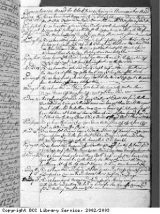The logbook from a slave ship
The following are extracts from the logbook of the Bristol slave ship the Black Prince, in 1762. The logbook remains intact today, a page from it is pictured here. The ‘Journal of an Intended Voyage in the Ship Black Prince from Bristol to the Gold Coast of Africa being Her 7th to the Coast commencing April the 24th 1762’ was kept by the captain William Miller. The owners of the ship were James Laroche & Co. The Black Prince left Bristol on 24th April 1762, arriving at the at the West African coast on 26th June. The ship stopped first at a place in West Africa called St Pauls, and over the next eight months moved around the coast buying slaves. The captain wrote:
‘30 June … at 3 am the long boat came on board with 17 gang casks of water and some Traders with two men slaves …
17 July … My Black [his black servant] called John Prince gave an impertinent answer to Mr Thomas 3rd Mate for which im giving him Correction. Told me he would be up with me for it upon which I put him in Irons and slaptd down on the Quarter Deck and put him on Bread and Water Prisoners fare til he knows better and to equivalat what he said told me wold run away as soon as he could …
3 August … The Pinnace returned Brought some rice but no slaves …
7 September …King Andrew came on board, gave him a kegg of brandy …[King Andrew was an African trader, probably nick-named by his British trading partner]
16 September … sailed down along Coast …
20 September … Some canoes came on board with some slaves but could not buy any but One Man …
27 September … Finds no Trade except old slaves or children …
28 October … purchased 4 slaves …
28 November … two girls down in the meazels …
2 December … washed the slaves fore and aft
3 December … Some slaves down in the Meazels and Feavers …
17 February [1763] … found the slaves intended taking [the ship]- two slaves Discovered there Intregue putt most Part of the Men in Chains to prevent there Intention …
22 February … found the Slaves was intending to rise got all under arms and soon got them quieted tho a great Number of them had Broke there Irons … found out 2 of which was the Ring Leaders which was well Flogged …’
The ship left the coast of Africa on 1 March 1763, bound for Antigua with 438 slaves on board.
‘3 March … Slaves is very indifferent with Colds and Purging … Woman No 11 died …
4 March … The slaves intended to make the other Attempt [uprising]. Am got up 10 of the Ring Leaders put them in one chain and whipt them … Died one girl of the flux No 12
7 March … Died the Ring Leader of the Insurrection …
8 March … One Woman is very bad, Many of them with purging and some falls away not eateing …
14 March … The slaves fore and aft falls away very much although no vizable complaint eat there vituals very well …
1 April … The Slaves still fall away and complain of gripeings and fluxes …
5 April … Many complaints forward one sick slave Endevered to Jump over Board …
10 April … Slaves is much worse and this dirty weather can’t get them up [on deck for washing and exercise] tho fall away …
12 April … Washing some of the Sick Women …
15 April … Dead one Man of Mortification in the Right Hip …
19 April … The Slaves still complaining of Gripeing and falls away as it have not been in our power to keep them up [on deck] half a day this month past …
20 April … Died at midday one [?]Dunas girl which the Slaves told the Doctor chocked. AM some words arose between him about vituals for the gunner in which I WM call’d him a scoundrel and ungratefull if he treated the slaves as they said …
27 April … Many of the Slaves will not eat bread beef rice nor beans …
29 April … Washed all the Slaves fore and aft the first time since we left the coast [first good weather] …
1 May … Washed the Rooms and Platforms fore and aft …’
The ship arrived on the Caribbean island of Antigua on 7 May with 394 of the original 438 slaves still alive.
‘9 May … [the agents who sell the slaves on behalf of the owners] came aboard and examined the Slaves … lett some of the slaves out of Irons …
12 … Shaving the slaves …’
From 16 May, the enslaved Africans were taken on shore to be sold. The ship loaded sugar and other goods on board, and sailed on 4 July, arriving at Bristol on 10 August.



